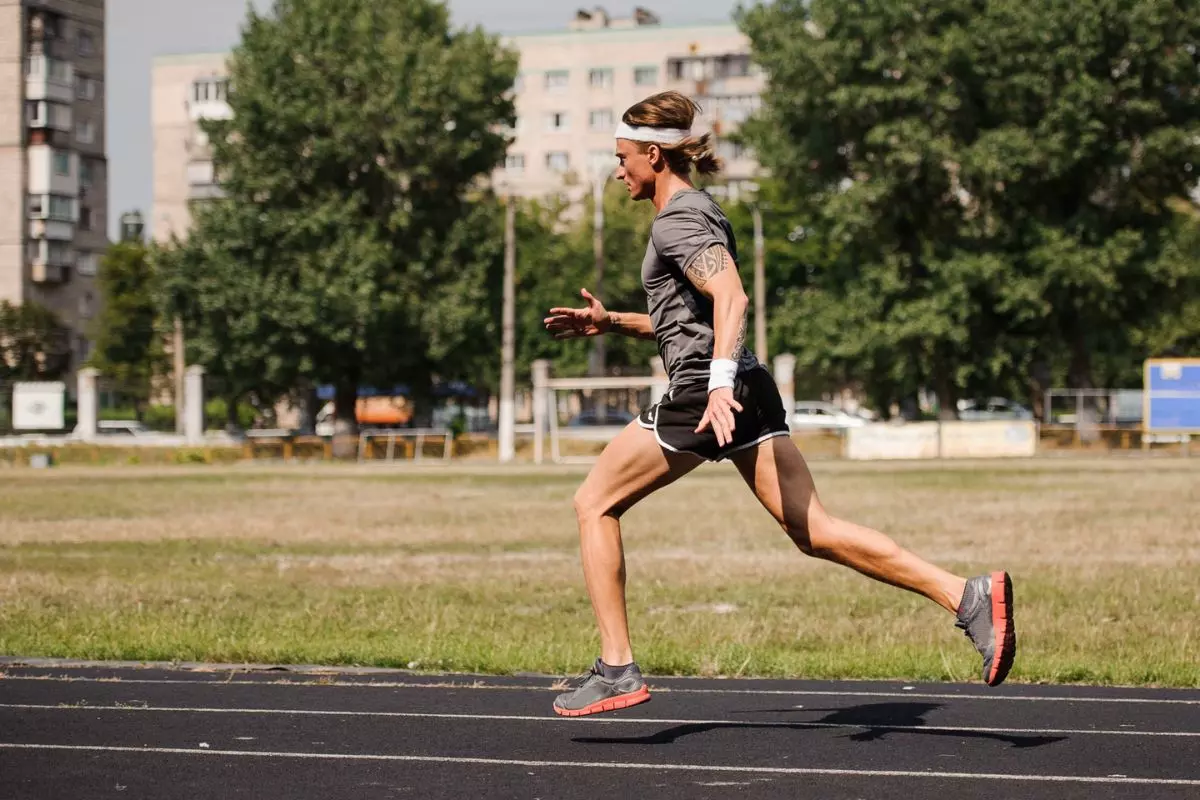Aerobic vs Anaerobic Running: 7 Benefits + Training Plans
Reviewed by: Ernesto Mendez (Orthopedic Clinical Specialist)
Are you a runner and wondering about the differences between anaerobic and aerobic running? Understanding the difference can help you identify techniques to improve your performance in running.
Many people wonder if is running an aerobic exercise? This post will help you understand what each type of running involves, how to recognize them during workouts, and tips on incorporating both types of training into your workout routine.
Get ready for a deep dive into anaerobic vs. aerobic exercise that will make you rethink your current strategies!
How can aerobic and anaerobic exercises improve marathon performance?
Aerobic running relies on oxygen processes to produce energy, while anaerobic exercises don’t need oxygen to perform explosive movements. Incorporating both aerobic and anaerobic exercises into a complete training program can significantly enhance performance for long-distance events such as marathons or triathlons.
What Is Aerobic Running?
Let’s start with an answer to the question “What is an aerobic run?” It is a form of cardiovascular exercise that relies on the oxygen in your body to produce energy for running. It is measured by monitoring heart rate, oxygen consumption, and the rate of perceived exertion.
- Heart rate helps to identify your individual level of exertion. Typically, tracking a runner’s heart rate in relation to their age will allow them to determine their maximal aerobic capacity at that given time.
- Oxygen consumption monitors how efficiently an athlete uses oxygen during exercise, which can help estimate athletic endurance levels and maximum racing potential when on the track.
- The rate of perceived exertion (RPE) provides useful insight into the intensity demanded by athletes throughout various stages of training.

7 Benefits of Aerobic Running
Let’s talk a bit more about the unique advantages of aerobic running.
1. Improved Speed and Muscle Efficiency
By engaging in aerobic training running, such as long-distance runs, muscles become more efficient at using oxygen to produce energy. This increases stamina and can lead to improved performance in all distance races.
2. Enhanced Recovery
The improved oxygen delivery and waste removal associated with aerobic running enhances recovery, which is of great benefit to runners. The muscular tissues become stronger and recover from fatigue more quickly.
3. Increased Capillary Count
Aerobic running increases the number of capillaries in the body, allowing for improved oxygen delivery and nutrient transfer. Through prolonged aerobic exercise, more oxygen can be taken up by the cells and greater amounts of fuel can be delivered to the muscles.
As a result, muscle performance improves, along with endurance levels. This process also reduces risk factors associated with heart disease, such as high blood pressure and the hardening of arteries.
4. Increased Mitochondrial Density
Mitochondria are the powerhouse of cells and play a vital role in providing energy to the body. Increased mitochondrial density is associated with the metabolic benefits of aerobic running.
Specifically, increased mitochondrial density leads to higher oxidative efficiency and improved oxygen consumption during aerobic exercise.
5. Increased Myoglobin Amounts
Myoglobin is a protein responsible for transporting oxygen within muscle cells. Slow-twitch muscle fibers that are associated with aerobic exercise contain more myoglobin than the fast-twitch muscle fibers often used in anaerobic activities.
As runners increase their aerobic capacity through training and exercises, their bodies will naturally produce more myoglobin.
6. Improved Aerobic Capacity
Aerobic capacity is your body’s ability to consume oxygen during exercise. When you improve your aerobic capacity, your lungs become more efficient at absorbing oxygen and delivering it to muscles throughout your body. This improvement in cardiovascular fitness leads to enhanced energy levels over longer distances and allows runners to better handle the stress associated with distance running.
7. Increased Aerobic Threshold
Regular aerobic exercise helps to increase your aerobic threshold. The aerobic threshold is the point at which your energy production changes from being mainly fueled by oxygen to a higher reliance on anaerobic sources.
Running at levels above this threshold involves intense muscular activity, where lactic acid builds up quickly and fatigue sets in quicker than usual. Knowing their aerobic threshold helps runners regulate exercise intensity, improve performance, reduce risk of overtraining and injury, and increase running distance without compromising quality.

How to Understand If You Are Engaging in Aerobic Running
Is running aerobic or anaerobic? To evaluate this, you should start by testing your breathing and heart rate while running. This will help you identify your aerobic zones.
How to Perform an Aerobic Running Test
One way to gauge your level of aerobic fitness is through an aerobic test. This usually involves running at a certain aerobic running pace for a specific amount of time and measuring your heart rate, oxygen consumption, and other physiological factors.

Pro Tip:
The “talk test” is another way to determine whether you are in an aerobic state. If conversing while under light exertion feels easy, then it’s likely that your exercise intensity is within the range for aerobic running. Running too hard will make talking difficult or prevent it altogether, indicating an anaerobic zone.
How to Improve Your Results: Aerobic Exercises for Running
Aerobic exercises are activities that increase your heart rate and breathing rate for a relatively long period of time, usually over an hour.
This type of activity allows your body to get used to sustaining more effort during periods of intense physical stress on race day, such as when running long distances.
There are many types of aerobic exercises for runners, depending on what goal they’re hoping to achieve. For example, activities like:
- Swimming or cycling can help strengthen the muscles commonly used while running and build endurance for longer races.
- Interval training may also be beneficial. This means alternating bursts of hard running with slower recovery jobs that allow the heart rate and respiration rates to return close to the resting state before ramping up again.
- Hill repeats will work those same muscles but provide an added challenge due to the incline, thereby helping improve stamina overall.
What Is Anaerobic Running?
Anaerobic running is a type of high-intensity exercise that involves short bursts of activity fueled by energy production without the use of oxygen.
There are several ways to measure the intensity of anaerobic running, including heart rate, lactate threshold, and VO2 max:
- Heart rate is the measure of the number of times your heart beats per minute.
- Lactate threshold is the point at which lactic acid starts to build up in your muscles.
- VO2 max is the maximum amount of oxygen your body can use during exercise.
Measuring anaerobic running can be challenging. It requires specialized equipment and expertise. However, with the right tools and techniques, runners can accurately examine their performance and make adjustments to their training plans.
3 Benefits of Anaerobic Running
Anaerobic exercise plays a vital role when it comes to improving running performance. Anaerobic running can benefit your body in three main ways:
1. Strengthens Muscles and Joints
Anaerobic exercise is a great way to build muscular strength and power. It involves short bursts of intense activity, such as resistance training, weightlifting, HIIT, powerlifting, plyometrics, sprinting, and circuit training.
By performing these exercises regularly, runners can strengthen their muscles and joints, which will help them run faster and with more efficiency while reducing the risk of injury from overuse or fatigue.
2. Increases Speed and Power
This type of exercise is ideal for runners looking for increased speed and power because it helps develop fast-twitch muscle fibers, which support explosive movements.
Studies have also shown that combining aerobic activities such as jogging with short bursts of anaerobic exercise can help produce maximal increases in speed performance. Incorporating various types of anaerobic workouts into your training regimen will increase workout efficiency due to improved neuromuscular coordination when compared to aerobic running alone.
Subscribe to Our Running Newsletter!
Get free running tips from renowned professional athletes and discounts from top-notch brands.
3. Boosts Metabolism and Fat Burning
Anaerobic running can be extremely powerful when it comes to boosting metabolism and promoting fat burning. These sessions typically involve shorter but more intense bursts of activity, such as sprinting or resistance exercises. Anaerobic activities burn calories both during workouts and after you have stopped exercising.
How to Understand If You Are Engaging in Anaerobic Running
To determine whether you are exercising anaerobically, track your breaths. Keep monitoring your breathing for several minutes to assess the intensity of the exercise. If you get out of breath, this indicates that you have crossed the line into the anaerobic zone.
How to Perform an Anaerobic Running Test
The most common way to measure this type of activity is by monitoring your heart rate during exercise session and comparing it with your maximum heart rate. Generally speaking, if your heart rate is consistently above 80% percent of your maximum heart rate, then you are engaging primarily in anaerobic running.
How to Improve Running Results: Anaerobic Running Exercises
There are several types of anaerobic workouts that runners can do to boost speed and power while reducing fatigue during runs or races.
- High-intensity interval training (HIIT) is one type of workout that can help build maximal strength and power quickly through short bursts of intensity separated by recovery intervals. They burn more calories, build muscle mass, increase speed, and help build efficient endurance.
- Other forms of high-intensity training such as plyometrics, hill running repeats, and agility drills are effective ways for runners to improve their stride length and turnover rate while developing better form at the same time.
- Speed workouts make use of moderate- to high-intensity efforts over shorter distances. This helps develop better neuromuscular coordination, which leads to improved performance on race day.
Aerobic vs. Anaerobic Running
A good running routine should focus on both aerobic and anaerobic exercises, as they complement each other well. Aerobic exercise increases the body’s cardiovascular fitness, endurance, and overall health by developing a larger foundation during training. Anaerobic activity is focused on improving power and intensity goals such as speed, agility, and strength.

Pro Tip:
Combining these two types of workouts can lead to better performance in races, increased speed for shorter runs, improved muscle efficiency for longer runs, and more efficient recovery time.
Because of the unique benefits of aerobic and anaerobic exercise, it is important that runners incorporate both forms of training into their regular fitness plans.
Aerobic and Anaerobic Training Plan for Runners
You can benefit from blending both types of training. To do this, create a comprehensive training plan that includes specific aerobic and anaerobic running workouts designed for different distances.
Examples of Aerobic Running Workouts
Aerobic running workouts involve low-intensity exercises of prolonged duration that help build endurance and develop cardiovascular fitness. Examples include swimming laps, running at an easy pace, cycling, taking long hikes, and going on long walks with spots of jogging.
Aerobic Training Plans for Different Distances
When training for running events, it is important to have an aerobic training plan that fits your race-specific needs. An aerobic running program should account for distance, pace, and the individual running intensity level.
For a 5K race, a training plan typically lasts 8-10 weeks. It includes a mix of short and long runs. You should aim to run at least 3-4 times a week, with one long run in your plan.
For a 10K race, your training plan should last 10-12 weeks and have longer runs to build endurance. You should run four to five times per week, with a mix of shorter interval or hill workouts and longer runs.
For a half-marathon, your training plan should last 12-16 weeks and include longer runs and tempo runs to build greater aerobic capacity. You should aim to run four to five times a week, with one long run on the weekends.
For a full marathon, create a plan that lasts 16-20 weeks. Include even longer runs and interval training to build endurance and speed. Try to run four to five times a week, with one long run on the weekends.
| Distance | Duration | Training plan |
|---|---|---|
| 5K | 8-10 weeks | a mix of short and long runs at least 3-4 times runs per week and 1 long run |
| 10K | 10-12 weeks | a mix of shorter interval or hill workouts and longer runs 4 to 5 runs per week |
| Half-marathon | 12-16 weeks | longer runs and tempo runs to build greater aerobic capacity 4 to 5 runs per week with one long run on the weekends |
| Full marathon | 16-20 weeks | even longer runs and interval training to build endurance and speed 4 to 5 runs per week with one long run on the weekends |
Examples of Anaerobic Running Workouts
Examples of anaerobic running exercises include sprints, explosive drills, added weight, and hill repeats.
Interval training/HIIT and strength exercises such as plyometrics combine anaerobic activities with power work to build your anaerobic capacity.

Anaerobic Training Plans for Different Distances
Anaerobic training plans use different exercises such as sprinting and high-intensity intervals for faster pace work and aerobic periods of slow running for endurance.
For a 5K training plan, focus on interval training. This means running at high intensity for short periods of time, with rest periods in between. An example workout could include five rounds of 400-meter sprints with a 90-second rest period in between each sprint.
For a 10K, continue with interval training, but increase the distance of each interval. An example workout could include three rounds of 800-meter sprints with a two-minute rest period in between each sprint.
For a half-marathon, incorporate both interval training and longer runs into your training routine. An example workout could include a six-mile run at a moderate pace, followed by three rounds of 1,000-meter sprints with a three-minute rest period in between each sprint.
For a marathon, focus on longer runs and incorporate interval training. An example workout could include a 10-mile run at a moderate pace, followed by three rounds of 1,200-meter sprints with a four-minute rest period in between each sprint.
| Distance | Training recommendations | Training sample |
|---|---|---|
| 5K | high intensity for short periods of time with rest periods in between | 5 rounds of 400-meter sprints with a 90-second rest period in between each sprint. |
| 10K | continue with interval training, but increase the distance of each interval | 3 rounds of 800-meter sprints with a 2-minute rest period in between each sprint. |
| Half-marathon | incorporate both interval training and longer runs | 6-mile run at a moderate pace, followed by 3 rounds of 1,000-meter sprints with a 3-minute rest period in between each sprint |
| Full marathon | focus on longer runs and incorporate interval training | a 10-mile run at a moderate pace, followed by 3 rounds of 1,200-meter sprints with a 4-minute rest period in between each sprint |
Example Training Week Showing a Blend of Aerobic and Anaerobic Training
Here is an example of a weekly training schedule that includes both aerobic and anaerobic training:
| Monday | Tuesday | Wednesday | Thursday | Friday | Saturday | Sunday |
|---|---|---|---|---|---|---|
| Rest day | Strength training | Speed work | Rest day | Endurance pace run | Short, intense intervals or hill sprints | Long, easy-pace run |
By alternating between different types of exercise throughout the week, you can improve both your aerobic capacity and anaerobic power.
Frequently Asked Questions about Aerobic Running
How Do I Build Aerobic Fitness for Running?
Those who are new to running should focus on gradually increasing mileage, as this strengthens your muscles and increases aerobic endurance. Once the basic foundation of consistent miles has been established, then you can try interval training, like hill repeats or variations of speed runs.
What Is the Aerobic Zone for Running?
The aerobic zone is the level of exertion during exercise that allows you to maintain your workout for a longer period of time. When running, this means keeping your heart rate at around 60-80% of your maximum heart rate. This is a great zone to train in to improve your cardiovascular fitness and endurance.
Is Long-Distance Running Aerobic or Anaerobic?
Long-distance running is primarily an aerobic exercise, as it relies on the body’s ability to process and use oxygen to create energy over a sustained period of time. This is different from anaerobic exercise, which involves short bursts of intense activity without the need for oxygen.
Final Thoughts on Aerobic Running
Aerobic and anaerobic training are both essential components of any running program. Aerobic runs help maintain and improve endurance by pushing the body to higher intensities with proper levels of oxygen, allowing muscles to make use of glucose and fats for energy production.
Anaerobic runs push your body to its limit, to a level where it is not using oxygen for performance. Examples of anaerobic running workouts include short, intense exercises that improve your explosive strength and speed.
Incorporating both aerobic and anaerobic exercises into a complete training program can lead to better performance in longer distance events, such as marathons or triathlons.
Do you include both anaerobic and aerobic running in your training plan? Please share your experience in the comments below.
Also read:
- Do You Wear Underwear With Running Shorts
- How to Run on Heavy Legs
- 8 Week 10K Training Plan
- Are Beans Good for Runners
- 22 Min 5K Pace
- How Long Does It Take to Run 2 Miles
- Best Beach Running Shoes
- Lactic Acid in Runners
- How Many Miles 15K
References:
- https://physoc.onlinelibrary.wiley.com/doi/epdf/10.1113/jphysiol.2003.057711 // The Journal of Physiology: https://physoc.onlinelibrary.wiley.com/doi/epdf/10.1113/jphysiol.2003.057711
- Adaptations of skeletal muscle mitochondria to exercise training // The Physiological Society: https://physoc.onlinelibrary.wiley.com/doi/10.1113/EP085319
- Aerobic vs anaerobic exercise training effects on the cardiovascular system // PMC: https://www.ncbi.nlm.nih.gov/pmc/articles/PMC5329739/
- Aerobic Exercise // Physiopedia: https://www.physio-pedia.com/Aerobic_Exercise
- Aerobic and Anaerobic Speed Predicts 800-m Running Performance in Young Recreational Runners // Frontiers: https://www.frontiersin.org/articles/10.3389/fphys.2021.672141/full
- Difference Between Aerobic and Anaerobic Exercise // WebMD: https://www.webmd.com/fitness-exercise/difference-between-aerobic-and-anaerobic-exercise
- What is aerobic vs anaerobic training // Nuffield Health: https://www.nuffieldhealth.com/article/what-is-aerobic-vs-anaerobic-training
- Minutes of hard exercise can lead to all-day calorie burn // EurekAler: https://www.eurekalert.org/news-releases/841026
If you have any questions or suggestions, you can contact us via email – [email protected]






